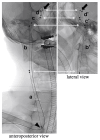Initial Experience in Assessing the Stability of the Rist Guide Catheter for Transradial Neurointerventions
- PMID: 40621297
- PMCID: PMC12228578
- DOI: 10.7759/cureus.85432
Initial Experience in Assessing the Stability of the Rist Guide Catheter for Transradial Neurointerventions
Abstract
Introduction: The Rist guide catheter is specifically designed for transradial neurointervention (TRN) and has demonstrated efficacy in accessing distal intracranial vessels, achieving a high success rate. We investigated the impact of catheter position on its stability during TRN.
Materials and methods: This retrospective study included 17 patients who underwent neuroendovascular procedures using the 7-French Rist guide catheter from March 2024 to February 2025. The procedures involved intracranial aneurysm and middle meningeal artery embolization. Catheter stability was evaluated based on its position and the effective catheter length (ECL), which is defined as the distance from the origin of the target vessel to the catheter tip.
Results: Stable catheter positioning was achieved in 13 out of 17 cases at the petrous segment of the internal carotid artery (ICA), the V3/4 segment of the vertebral artery (VA), and the distal external carotid artery (ECA) segment. The petrous segment corresponded to an ECL of approximately 20 cm, while the V3/4 or distal ECA segments corresponded to 16 cm. One case required switching to femoral access, but the procedure was successful in all cases, with no access site complications observed.
Conclusion: Our initial experience demonstrated that the position of the Rist catheter was relevant to its stability during TRN. Understanding its behavior would improve preprocedural planning and contribute to successful outcomes.
Keywords: cerebral aneurysm surgery; chronic subdural hematoma (csdh); rist guide catheter; transradial approach; transradial neurointervention.
Copyright © 2025, Kozaki et al.
Conflict of interest statement
Human subjects: Consent for treatment and open access publication was obtained or waived by all participants in this study. Animal subjects: All authors have confirmed that this study did not involve animal subjects or tissue. Conflicts of interest: In compliance with the ICMJE uniform disclosure form, all authors declare the following: Payment/services info: All authors have declared that no financial support was received from any organization for the submitted work. Financial relationships: All authors have declared that they have no financial relationships at present or within the previous three years with any organizations that might have an interest in the submitted work. Other relationships: All authors have declared that there are no other relationships or activities that could appear to have influenced the submitted work.
Figures



References
-
- Neuroendovascular surgery. Riina HA. J Neurosurg. 2019;131:1690–1701. - PubMed
-
- Radial artery catheterization for neuroendovascular procedures. Khanna O, Sweid A, Mouchtouris N, et al. Stroke. 2019;50:2587–2590. - PubMed
-
- The Rist radial access system: a multicenter study of 152 patients. Abecassis IJ, Saini V, Crowley RW, et al. J Neurointerv Surg. 2022;14:403–407. - PubMed
LinkOut - more resources
Full Text Sources
Miscellaneous
